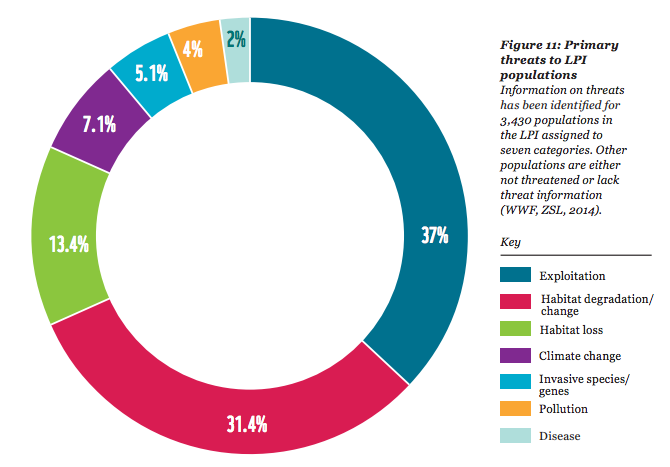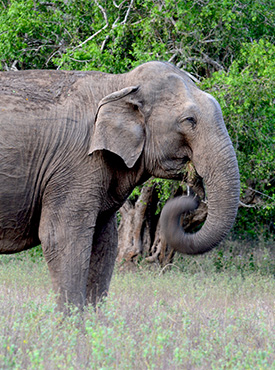2017 Dec 4
A 2011 report in the journal PLoS Biology, said to be the most accurate ever, estimated the total species count on this planet to be ~7.7 Million. Of that vertebrate animals make up 80,500 species, while insects and other invertebrates total ~6.7 Million species. Humans are only but 1 species of these 7 million species of life living on Planet Earth. We are also the ruling species, meaning we are the dominant species on the planet today.
While Planet Earth is about 4.54 billion years old and first life dates to at least 3.5 billion years ago, when you look at the facts, we have only been on this planet for a blink of an eye!
While our early ancestors have been around for about 6 million years, the modern form of humans evolved only about 200,000 years ago. Civilization as we know it is only about 6,000 years old, and the industrial revolution began in the 1800s.
To put that into perspective:
|
Wildlife |
How long have they been on Earth |
| Elephants | 55 million years |
| Monkeys | 65 million years |
| Frogs | 190 million years |
| Crocodiles | 200 million years |
| Turtles | 220 million years |
| Fish | 530 million years |
So as you can see, we are relative new-comers to the neighbourhood.
It has only been around 2 centuries since the industrial revolution however, we humans have forever marred our landscape and with it,all life on the planet. Every year, we cut down more forests, use up more natural resources that can be naturally replenished, and destroy our last remaining natural environments, taking away more habitat from the wildlife who share this planet with us and in many casesdriveother species into endangerment and extinction.
According to WWF the world has lost over 50% of its wildlife just in the past 40 years.
The report states that creatures, both on land and in the water, have been decimated by unsustainable hunting practices.The majority of the general decline has occurred in low-income and developing nations such as Sri Lanka.

Some shocking facts from the recent conservation documentary ‘Racing Extinction’:
• Half of all species will be gone in 100 years
• We are going through the 6th mass extinction
• 75% of the world fish populations are removed faster than they can reproduce
• 200,000 sharks are killed every day for the shark fin trade (shark fin soup)
• coral bleaching has impacted 40% of the world’s coral reefs
• Orangutans can be extinct in the wild in the next 25 years
• Every 15 minutes an elephant is killed for their ivory
Let’s talk about species extinction in a Sri Lankan context:
There are 125 mammal species in Sri Lanka, of which 1 is critically endangered, 10 are endangered, 10 are vulnerable, and 3 are near-threatened. (Source: 2004 IUCN Red List of Threatened Animals.)
Critically Endangered:
- Nillu Rat (Rattusmontanus). (Endemic to Sri Lanka.)
Endangered:
- Asian Elephant (Elephas maximus)
- Blue Whale (Balaenopteramusculus)
- Fin Whale (Balaenopteraphysalus)
- Jungle Shrew (Suncuszeylanicus) (Endemic to Sri Lanka)
- Kelaart’s Long-clawed Shrew (Feroculusferoculus) (Endemic to Sri Lanka)
- Pearson’s Long-clawed Shrew (Solisorexpearsoni) (Endemic to Sri Lanka)
- Purple-faced Leaf Monkey (Trachypithecusvetulus) (Endemic to Sri Lanka)
- Sri Lankan Long-tailed Shrew (Crociduramiya) (Endemic to Sri Lanka)
- Sri Lanka Shrew (Suncusfellowsgordoni) (Endemic to Sri Lanka)
Vulnerable:
- Dhole (Cuonalpinus)
- Dugong (Dugongdugon).
- Eurasian Otter (Lutralutra)
- Fishing Cat (Prionailurusviverrinus)
- Humpback Whale (Megapteranovaeangliae)
- Nolthenius’s Long-tailed Climbing Mouse (Vandeleurianolthenii). (Endemic to Sri Lanka)
- Rusty-spotted Cat (Prionailurusrubiginosus)
- Sloth Bear (Melursusursinus)
- Slow Loris (Loristardigradus)
- Sperm Whale (Physetercatodon)
- Sri Lankan Giant Squirrel (Ratufamacroura)
- Sri Lankan Highland Shrew (Suncusmontanus)
- Toque Macaque (Macacasinica) (Endemic to Sri Lanka)
If that didn’t get you to sit up and take notice:
Amphibians – out of the 34 species of amphibians confirmed as extinct worldwide in the past 500 years, 21 are from Sri Lanka
Crab – Sri Lankan crabs are highly endemic and 46 out of the 51 species of crab are threatened. nearly 90% of the freshwater crabs in Sri Lanka are globally threatened with 66% being listed under the critically endangered category.
Reptiles – 107 out of 211 species of reptiles, including marine reptiles, are under threat. This includes crocodiles, sea turtles, horn lizards, geckos and snakes
“Of the surviving inland vertebrates, 122 species are Critically Endangered: i.e., one in every 6 species of inland indigenous vertebrates of Sri Lanka is currently facing a high risk of extinction in the wild.” Professor Devaka Weerakoon, IUCN Red List lead consultant and Professor in Zoology, Faculty of Science, University of Colombo.
Some may argue that extinction is a normal part of evolution. But how is the 6th Extinction different from previous events? The current mass extinction is caused by humans.
Direct human impact, including carbon emissions, climate change, overfishing, illegal wildlife trade, habitat destruction and overconsumption are the overwhelming reasons for the current extinction taking place across the globe. And it is happening on our very own little island.
With an exploding population (8 million in 1953 vs 21 million today), it is no surprise that Sri Lanka is named a biodiversity hotspot. Expanding human population means increased stress on the land and greater habitat loss as well as other challenges for the island’s wildlife.
The elephant is probably Sri Lanka’s most iconic wild animal and as of today it is listed as endangered. Even though certain reports indicate there may be 5,000 elephants left in the wild in Sri Lanka, in actual fact the numbers could be far less. We do know however, that approx. 200 elephants are killed each year due to the Human Elephant Conflict (HEC). The prohibition of chena cultivation and fragmented forest lands have worsened the problem.
Those with an interest in wildlife would have followed the heartbreaking story which unfolded last week, regarding the beloved tusker of Galgamuwa.
The Galgamuwe Dala Poottuwa or ‘crossed tusker’ was a 45-year-old, almost 10-foot-tall, well-built male elephant who lived in the Galgamuwa area. The tusker has been blind for almost the last decade after being shot in the eyes, most likely due to the HEC. The blind tusker was known to shake mango trees in village gardens and suck up the fallen mangoes into his mouth. An adult elephant needs about 300 pounds of food a day and the blind Galgamuwe tusker used his sense of smell to find food. No doubt his life must have been extremely challenging since going blind.
However, it was neither his lack of sight or the HEC, that claimed the life of the famous tusker. It was the illegal ivory trade. Villagers, environmentalists and animal welfare activists feared the worst when the large tusker had not been seen in two months. It was with great heartache that most in the country learned, that the rotting carcass found in the Kahalla Pallekele Sanctuary on the 29th of November, was in fact our beloved Galgamuwe tusker. The Galgamuwa Dala Puttuwa, one of the most iconic tuskers of Sri Lanka, had been heinously killed for his ivory by a group of men, including government servants.
On the same day the carcass of the Galgamuwa tusker was found, another large tusker was shot and killed in the Tabbowa sanctuary on Tuesday night by poachers. The dead tusker with three foot long tusks, was found near the Naulla tank in Tabbowa by the Karuwalagaswewa Wildlife officers. A post mortem revealed that the elephant died due to gunshot wounds to its chest.It is worth noting that the world’s biggest Ivory market is China and according to the U.N., up to 100 elephants are being slaughtered a day in Africa by poachers taking part in this illegal ivory trade.
Earlier in the month, the police seized 130 kilograms of pangolin scales from a house at Tiladiya in Kalpitiya. only around 750 grams of scales can be collected after killing a pangolin and to collect 134 kgs, the suspects may have killed around 150 pangolins. The Police said that the suspects had confessed that the Pangolin scales were to be shipped to China via India.
Sri Lanka’s wildlife had many challenges until now, but with increasing relations with China, it looks like our precious wildlife are now in even greater risk, this time by wildlife poachers looking to make a quick buck at the cost of the life of an innocent animal, and at the cost of species extinction.
“Wildlife crime is a serious crime, not a distant problem in a faraway country” WWF
During the “Wildlife Trafficking and Conservation: A Call to Action” event held in America, Secretary Clinton outlined the White House’s strategy to address the global problem of wildlife trafficking. These efforts are estimated to cost between $7 and $10 billion dollars a year.
“Wildlife cannot be manufactured. And once it’s gone, it cannot be replenished. Those who profit from it illegally are not just undermining our borders and our economies, they are truly stealing from the next generation.”
What can you do?
We as Sri Lankans must not stand by. Our wildlife is a precious heritage that belongs to us all and we must rise up to defend it. On this World Wildlife Conservation Day, you too can contribute to the conservation of our precious wildlife. Here’s how:
- Learn more about them – for example, did you know elephants are regarded as an “umbrella species” because their conservation will also protect a large number of other species occupying the same area. They are also a premier “flagship species” and are sometimes regarded as a “keystone species” because of their important ecological role and impact on the environment? Losing them has long term impacts which we may not realize today.
- Fight habitat loss – plant native trees in your area, join reforesting projects, fight deforestation
- Reduce, reuse, recycle – Plastic waste kills more than 1 million sea birds and 100,000 marine mammals each year. Make a pledge to stop using single-use plastics like bottled water & shopping bags
- Eat sustainable – adopt a diet high in plant-based foods, it’s the most sustainable and responsible way to feed yourself
- Be a ‘conscious traveler’ when you’re on holiday – find out how unknowingly you may contribute to the suffering of wildlife and practice responsible, guilt-free tourism.
- Learn, educate and inspire – knowledge is power, so find out more about the threats to our wildlife and educate others, inspiring those around you to be defenders of our precious wildlife
- Stand up and fight– Join local rallies and protests fighting for the protection of Sri Lanka’s wildlife and their last remaining habitats. There is a rally at 2pm on the 14th of December at Viharamahadevi Park, to protect Sri Lanka’s Wilpattu forest from ongoing deforestation. Show your support for our wildlife and join us in this peaceful protest. Find out more via: Facebook page @protectvilpattu (Note, as of 2015, 4,000 acres of forest has been cleared in and around the Wilpattu Forest Complex which is Sri Lanka’s largest primal forests and a unique eco-system as well as being prime elephant habitat.)







